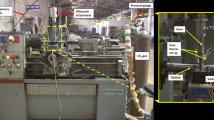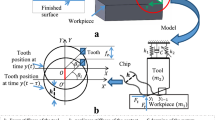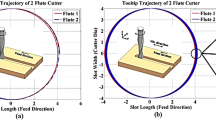Abstract
Ultrasonic vibration–assisted grinding is an effective method for improving the surface quality of brittle and hard materials. The grinding force is one of the key factors affecting the surface quality of the machined surface, and this has been investigated both experimentally and theoretically. However, the influence of process parameters on grinding forces during longitudinal ultrasonic vibration-assisted grinding (LUVAG) of alumina ceramics has not been studied in depth. To investigate the effects of various parameters on the grinding forces of LUVAG of alumina ceramics, the kinematic theory of LUVAG was combined with the effective cutting trajectory of transient single-grain abrasives and the effective removal of transient material to develop a LUVAG alumina ceramic grinding force model and a LUVAG endface grinding force model. The experimental results showed that the grinding depth (ap) and table speed (vw) were positively correlated with the tangential grinding force (Ft) and the normal grinding force (Fn) (when vw increased from 400 to 1000 mm/min, Ft increased by about 10 to 15% and Fn increased by 30 to 45%; when ap increased from 5μm to 20μm, Ft increased by 20 to 30%, Fn increases by 25 to 30%). The ultrasonic amplitude (A) is negatively correlated with the grinding force (when A increases from 4 to 12μm, Ft decreases by 5 to 10% and Fn decreases by 25 to 30%). The grinding wheel speed (vs) was positively correlated with Ft but negatively correlated with Fn (when the grinding wheel speed increased from 1400 to 3500r/min, Ft increased by 20 to 36% and Fn decreased by 30 to 46%). According to the range analysis, Ft is the minimum when ap=5μm, vs =1400 r/min, A=12μm, vw=600 mm/min, and Fn is the minimum when ap =5μm, vs =3500 r/min, vw =600 mm/min, A=12μm. The results of the theoretical model calculations show that the predicted values of the grinding forces for the given parameters are in general agreement with the experimental results. The maximum relative mean error between the theoretical and experimental results was 12.3%, while the overall relative mean error was 4.94%. At the same time, it was demonstrated that the model can assist orthogonal experiments for factor selection and scheme optimization, which has important practical application value.











Similar content being viewed by others
Data availability
Not applicable.
References
Gu W, Yao Z, Liang X (2011) Material removal of optical glass BK7 during single and double scratch tests. Wear 270:241–246. https://doi.org/10.1016/j.wear.2010.10.064
Yao Z, Gu W, Li K (2012) Relationship between surface roughness and subsurface crack depth during grinding of optical glass BK7. J Mater Process Technol 212:969–976. https://doi.org/10.1016/j.jmatprotec.2011.12.007
Taylor SR, Sieradzki K (2003) The development of a multi-functional aerospace coating: considerations in the use of nano-dimensioned materials. Prog Org Coat 47:169–173. https://doi.org/10.1016/S0300-9440(03)00136-X
Singh K, Bala I, Kumar V (2009) Structural, optical and bioactive properties of calcium borosilicate glasses. Ceram Int 35:3401–3406. https://doi.org/10.1016/j.ceramint.2009.06.006
Halverson S, Roy A, Mahadevan S et al (2015) An efficient, compact, and versatile fiber double scrambler for high precision radial velocity instruments. The AstrophySICal Journal 806:61. https://doi.org/10.1088/0004-637X/806/1/61
Agarwal S, Rao PV (2008) Experimental investigation of surface/subsurface damage formation and material removal mechanisms in SIC grinding. Int J Mach Tools Manuf 48:698–710. https://doi.org/10.1016/j.ijmachtools.2007.10.013
Lu S, Gao H, Bao Y, Xu Q (2019) A model for force prediction in grinding holes of SICp/Al composites. Int J Mech Sci 160:1–14. https://doi.org/10.1016/j.ijmecsci.2019.06.025
Patnaik Durgumahanti US, Singh V, Venkateswara RP (2010) A new model for grinding force prediction and analysis. Int J Mach Tools Manuf 50:231–240. https://doi.org/10.1016/j.ijmachtools.2009.12.004
Zhang Y, Li C, Ji H et al (2017) Analysis of grinding mechanics and improved predictive force model based on material-removal and plastic-stacking mechanisms. International Journal of Machine Tools and Manufacture 122:81-97. https://doi.org/10.1016/j.ijmachtools.2017.06.002
Doman DA, Warkentin A, Bauer R (2009) Finite element modeling approaches in grinding. Int J Mach Tools Manuf 49:109–116. https://doi.org/10.1016/j.ijmachtools.2008.10.002
Yang M, Li C, Zhang Y, Jia D, Zhang X, Hou Y, Li R et al (2017) Maximum undeformed equivalent chip thickness for ductile-brittle transition of zirconia ceramics under different lubrication conditions. Int J Mach Tools Manuf 122:55–65. https://doi.org/10.1016/j.ijmachtools.2017.06.003
Yang M, Li C, Zhang Y, Jia D, Li R, Hou Y, Cao H et al (2019) Predictive model for minimum chip thickness and size effect in single diamond grain grinding of zirconia ceramics under different lubricating conditions. Ceram Int 45:14908–14920. https://doi.org/10.1016/j.ceramint.2019.04.226
Jia D, Li C, Zhang Y, Yang M, Zhang X, Li R, Ji H Experimental evaluation of surface topographies of NMQL grinding ZrO2 ceramics combining multiangle ultrasonic vibration. Int J Adv Manuf Technol 100(1):457–473. https://doi.org/10.1007/s00170-018-2718-y
Gao T, Zhang X, Li C, Zhang Y, Yang M, Jia D, Ji H et al (2020) Surface morphology evaluation of multi-angle 2D ultrasonic vibration integrated with nanofluid minimum quantity lubrication grinding. J Manuf Process 51:44–61. https://doi.org/10.1016/j.jmapro.2020.01.024
Chen Y, Su H, Qian N, He J, Gu J, Xu J, Ding K (2021) Ultrasonic vibration-assisted grinding of silicon carbide ceramics based on actual amplitude measurement: grinding force and surface quality. Ceram Int 47:15433–15441. https://doi.org/10.1016/j.ceramint.2021.02.109
Xiong Y, Wang W, Jiang R, Huang B, Liu C (2022) Feasibility and tool performance of ultrasonic vibration-assisted milling-grinding SICf/SIC ceramic matrix composite. J Mater Res Technol 19:3018–3033. https://doi.org/10.1016/j.jmrt.2022.06.063
Dornfeld D, Min S, Takeuchi Y (2006) Recent advances in mechanical micromachining. CIRP Annals 55:745–768. https://doi.org/10.1016/j.cirp.2006.10.006
Zhang X, Yu T, Zhao J (2020) An analytical approach on stochastic model for cutting force prediction in milling ceramic matrix composites. Int J Mech Sci 168:105314. https://doi.org/10.1016/j.ijmecsci.2019.105314
Yao L, Liu Z, Song Q, Wang B, Cai Y (2023) Prediction modelling of cutting force in rotary ultrasonic end grinding 2.5D woven SiO2f/SiO2 ceramic matrix composite. Compos Struct 304:116448. https://doi.org/10.1016/j.compstruct.2022.116448
An Q, Chen J, Ming W, Chen M (2021) Machining of SIC ceramic matrix composites: a review. Chinese J Aeronaut 34:540–567. https://doi.org/10.1016/j.cja.2020.08.001
Ding W, Huang Q, Zhao B, Cao Y, Tang M, Deng M, Liu G et al (2023) Wear characteristics of white corundum abrasive wheel in ultrasonic vibration-assisted grinding of AISI 9310 steel. Ceram Int 49:12832–12839. https://doi.org/10.1016/j.ceramint.2022.12.153
Yu T, Guo X, Wang Z, Xu P, Zhao J (2019) Effects of the ultrasonic vibration field on polishing process of nickel-based alloy Inconel718. J Mater Process Technol 273:116228. https://doi.org/10.1016/j.jmatprotec.2019.05.009
Nik MG, Movahhedy MR, Akbari J (2012) Ultrasonic-assisted grinding of Ti6Al4V alloy. Procedia CIRP 1:353–358. https://doi.org/10.1016/j.procir.2012.04.063
Jiang J, Sun S, Wang D et al (2020) Surface texture formation mechanism based on the ultrasonic vibration-assisted grinding process. Int J Mach Tools Manuf 156:103595. https://doi.org/10.1016/j.ijmachtools.2020.103595.
Zhang K, Yin Z, Dai C et al (2023) Material removal mechanism of sic ceramics by elliptic ultrasonic vibration-assisted grinding (euvag) using single grain. Ceram Int 49:10041–10055. https://doi.org/10.1016/j.ceramint.2022.11.184
Lv D, Zhang Y, Peng Y (2016) High-frequency vibration effects on hole entrance chipping in rotary ultrasonic drilling of BK7 glass. Ultrasonics 72:47–56. https://doi.org/10.1016/j.ultras.2016.07.011
Wu H, Duan W, Sun L et al (2023) Effect of ultrasonic vibration on the machining performance and mechanism of hybrid ultrasonic vibration/plasma oxidation assisted grinding. J Manuf Process 94:466–478. https://doi.org/10.1016/j.jmapro.2023.03.067
Yang Z, Zou P, Zhou L et al (2022) Research on modeling of grinding force in ultrasonic vibration–assisted grinding of 304 stainless steel materials. Int J Adv Manuf Technol 120:3201–3223. https://doi.org/10.1007/s00170-022-08962-2
Huang C, Zhou M, Zhang H (2022) Investigations on the micro-interactions of grit-workpiece and forces prediction in ultrasonic vibration side grinding of optical glass. J Mater Process Technol 300:117415. https://doi.org/10.1016/j.jmatprotec.2021.117415
Dai C, Yin Z, Ding W, Zhu Y (2019) Grinding force and energy modeling of textured monolayer CBN wheels considering undeformed chip thickness nonuniformity. Int J Mech Sci 157-158:221–230. https://doi.org/10.1016/j.ijmecsci.2019.04.046
Wang Y, Lin B, Wang S, Cao X (2014) Study on the system matching of ultrasonic vibration assisted grinding for hard and brittle materials processing. Int J Mach Tools Manuf 77:66–73. https://doi.org/10.1016/j.ijmachtools.2013.11.003
Wang Y, Lin B, Zhang X (2014) Research on the system matching model in ultrasonic vibration-assisted grinding. Int J Adv Manuf Technol 70:449–458. https://doi.org/10.1007/s00170-013-5269-2
Code availability
Not applicable.
Funding
This research was supported by the National Natural Science Foundation of China project “Research on Subsurface Damage Mechanism of High-speed Multidimensional Ultrasound Machining of Ceramic Matrix Composites” (Project Code: 52005164), Henan Polytechnic University Doctoral Program Fund (B2016-27) “Research on Vehicle Condition Monitoring and Fault Diagnosis Based on Optimized Support Vector Machine,” and Henan Polytechnic University Doctoral Program Fund (B2012-105).
Author information
Authors and Affiliations
Contributions
All related authors contributed to the conceptualization; data curation; investigation; methodology; writing—original draft; writing—review; and editing of the manuscript.
Corresponding author
Ethics declarations
Ethics approval
This paper is new. Neither the entire paper nor any part of its content has been published or has been accepted elsewhere. It is not being submitted to any other journal as well.
Consent to participate
Not applicable.
Consent for publication
Not applicable.
Conflict of interest
The authors declare no competing interests.
Additional information
Publisher’s note
Springer Nature remains neutral with regard to jurisdictional claims in published maps and institutional affiliations.
Rights and permissions
Springer Nature or its licensor (e.g. a society or other partner) holds exclusive rights to this article under a publishing agreement with the author(s) or other rightsholder(s); author self-archiving of the accepted manuscript version of this article is solely governed by the terms of such publishing agreement and applicable law.
About this article
Cite this article
Zhao, M., Xue, B., Li, B. et al. Modeling of grinding force in longitudinal ultrasonic vibration–assisted grinding alumina ceramics and experimental evaluation. Int J Adv Manuf Technol 131, 2325–2339 (2024). https://doi.org/10.1007/s00170-023-11590-z
Received:
Accepted:
Published:
Issue Date:
DOI: https://doi.org/10.1007/s00170-023-11590-z




